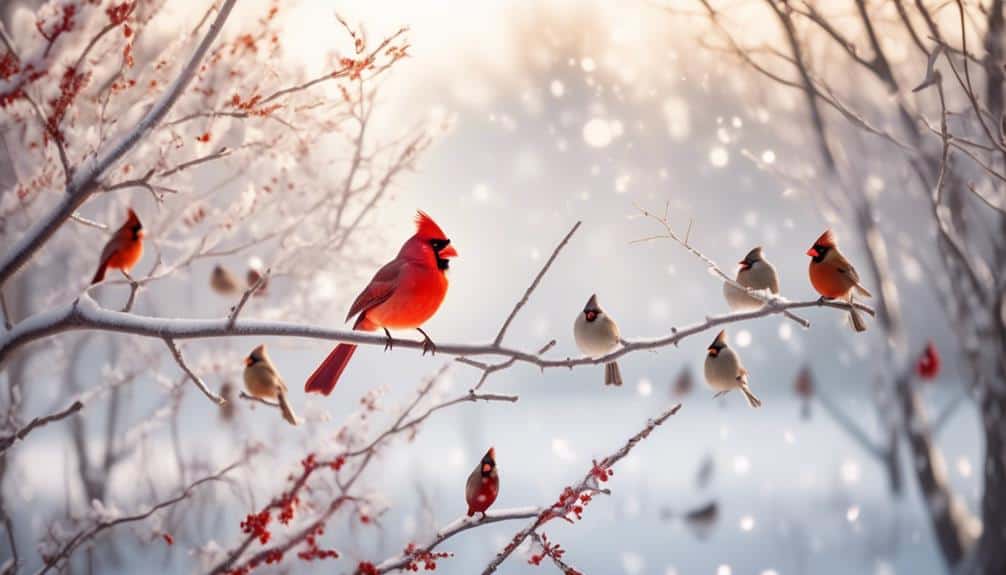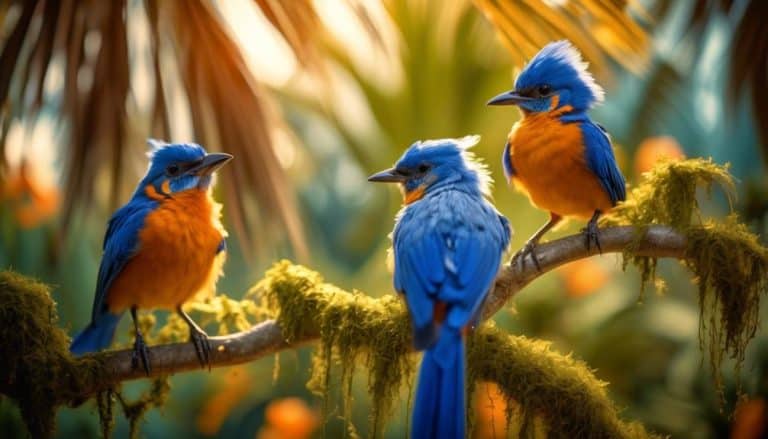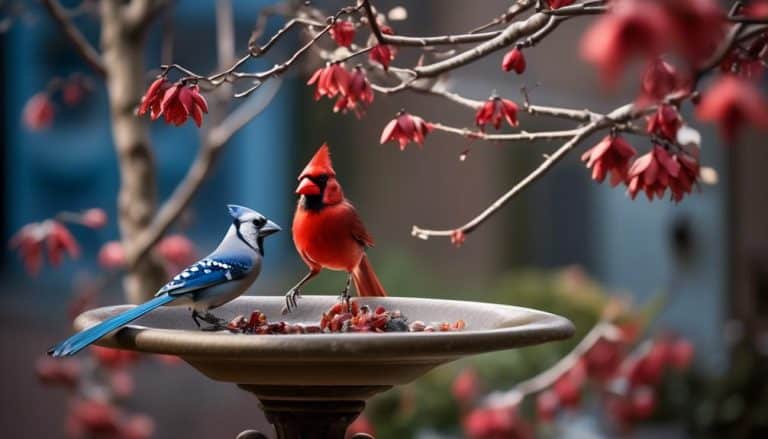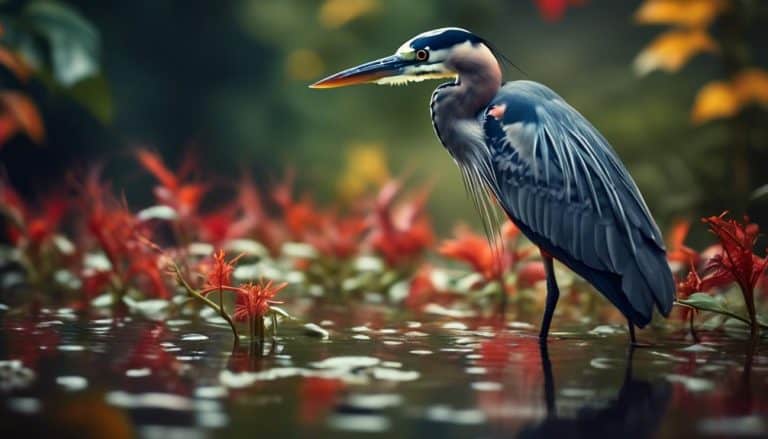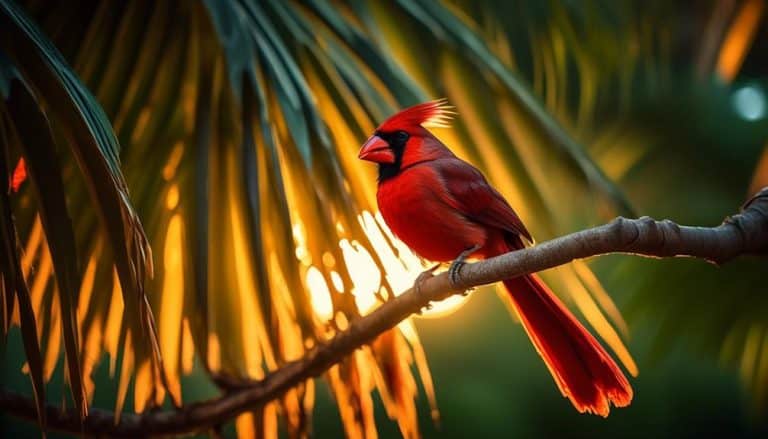As I stepped outside on a frosty morning, I couldn't help but notice a flash of white soaring in the sky above me. It was a magnificent bald eagle, gracefully navigating the winter landscape of Wisconsin.
Winter brings about a unique opportunity to observe a variety of birds in this region, each with their own fascinating adaptations for surviving the harsh conditions. From the lively chickadee to the elusive snow bunting, Wisconsin is a haven for winter birds.
So, let's embark on a journey to discover the wonders of these feathered creatures and the best places to catch glimpses of them in the cold months ahead.
Winter Birds in Wisconsin: An Overview
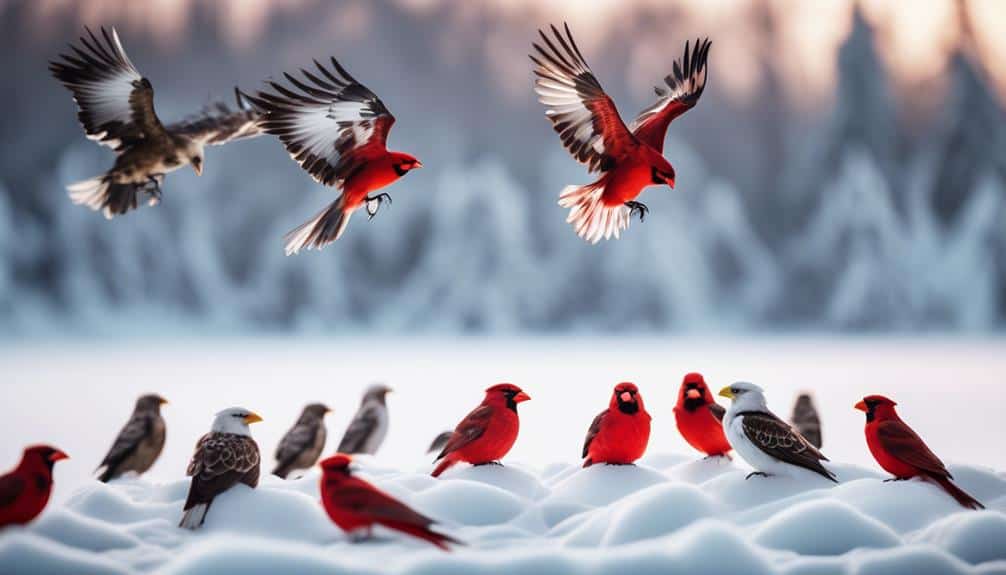
During the winter months in Wisconsin, an abundance of avian species can be observed, making it a prime location for bird enthusiasts and researchers alike. One of the most fascinating aspects of winter bird activity in Wisconsin is the phenomenon of winter bird migration. Many bird species migrate to Wisconsin during the winter months in search of milder temperatures and abundant food sources. This migration is a remarkable feat of endurance and navigation, as birds travel thousands of miles to reach their wintering grounds.
Bird feeding strategies also play a crucial role in the survival of winter birds in Wisconsin. With limited food resources available during the cold winter months, birds have developed various feeding strategies to sustain themselves. Some birds, such as chickadees and nuthatches, store food during the summer and fall months, creating hidden caches that they can rely on during the winter. Others, like woodpeckers, have specialized bills that allow them to extract insects from tree bark, providing them with a reliable food source even when the ground is covered in snow.
Understanding winter bird migration and bird feeding strategies is essential for researchers and bird enthusiasts in Wisconsin. By studying these behaviors, we can gain insights into the ecological dynamics of winter bird populations and contribute to their conservation and management.
The Majestic Bald Eagle

The Majestic Bald Eagle, with its striking white head and powerful wingspan, is a captivating sight in the winter skies of Wisconsin. Here are four intriguing facts about this iconic bird:
- Conservation Efforts: The Bald Eagle population in Wisconsin has made a remarkable recovery thanks to dedicated conservation efforts. Once facing the threat of extinction due to habitat loss and pesticide poisoning, these majestic birds have now made a strong comeback.
- Nesting Habits: Bald Eagles build their nests, called eyries, in large trees near bodies of water. These nests can reach enormous sizes, sometimes weighing up to a ton! The eagles return to the same nest year after year, adding to it and repairing it as needed.
- Winter Migration: While some Bald Eagles remain in Wisconsin year-round, many migrate from northern Canada and the Great Lakes region to spend the winter here. They're attracted by the open water and abundant fish, which provide them with a reliable food source during the colder months.
- Soaring Predators: The Bald Eagle's wingspan can reach up to 7 feet, allowing them to effortlessly glide through the skies. They possess incredible eyesight, capable of spotting prey from great distances. With their powerful talons, they can snatch fish from the water's surface or steal from other birds.
The conservation efforts and nesting habits of the Bald Eagle have played a vital role in their survival and resurgence in Wisconsin. As I watch these magnificent birds soar above, I'm reminded of their resilience and the importance of protecting their habitat for future generations to admire.
The Lively Chickadee
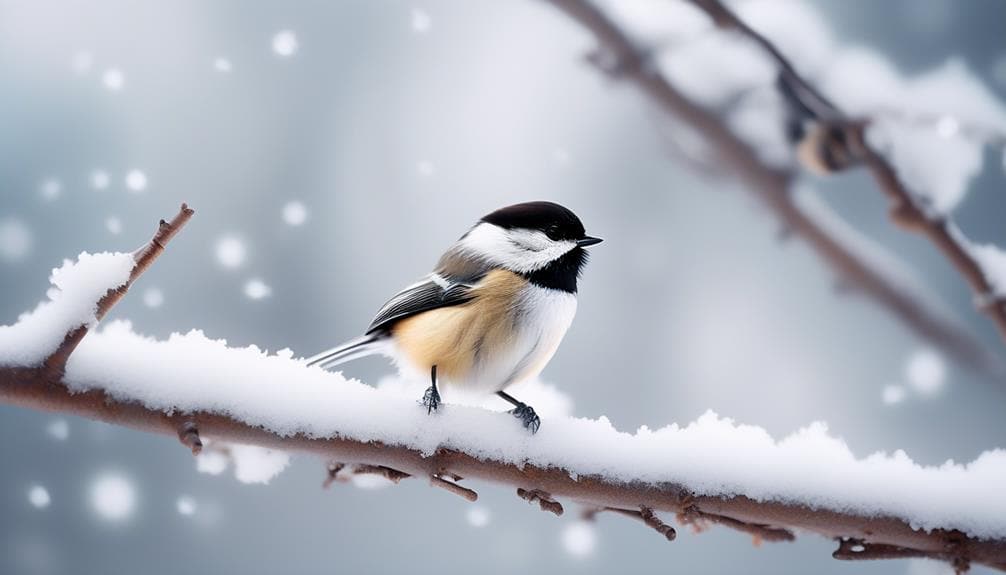
What makes the lively Chickadee such a fascinating winter bird in Wisconsin? The Chickadee, scientifically known as the Poecile atricapillus, exhibits unique behaviors and nesting habits that make it a captivating species to observe during the winter months.
Chickadees are small, energetic birds with distinctive black caps and white cheeks. They're known for their acrobatic flights and agile movements as they flit from tree to tree in search of food. These birds have a curious nature and are often seen investigating cracks and crevices, looking for insects and seeds to sustain them throughout the winter. Their ability to hang upside down or sideways while foraging is truly remarkable.
When it comes to nesting, Chickadees are resourceful and adaptable. They often choose tree cavities or abandoned woodpecker holes as their preferred nesting sites. They meticulously build nests using moss, grass, and other plant materials, creating a cozy and well-insulated home for their young. These nests are carefully constructed to ensure the safety and warmth of their offspring during the harsh winter months.
Adaptations for Surviving the Harsh Winter

As winter settles in Wisconsin, the Chickadee's remarkable adaptations come to the forefront, allowing this lively bird to thrive in the face of harsh conditions. Here are four fascinating adaptations that help the Chickadee survive the winter:
- Feeding strategies: During the winter months, when food is scarce, Chickadees employ a unique foraging technique called 'perching and pecking.' They perch on branches, scan their surroundings for hidden insects and insect eggs, and then quickly peck at them to extract the much-needed nutrients.
- Migration patterns: While some birds migrate south for the winter, Chickadees have adapted to stay put in Wisconsin. Their ability to survive the harsh winters is due in part to their ability to lower their body temperature and enter a state of controlled hypothermia. This helps conserve energy and allows them to withstand the freezing temperatures.
- Thick plumage: The Chickadee's feathers play a crucial role in insulating their bodies from the cold. Their plumage is thick and fluffy, providing excellent insulation and reducing heat loss. Additionally, they've a layer of down feathers close to their skin, which traps air and acts as an additional insulating layer.
- Food storage: Chickadees have a remarkable ability to stash away food for later. They've been known to hide thousands of food caches throughout their territory, using their excellent spatial memory to remember the locations. These hidden food sources provide a vital lifeline during the winter when other food sources are scarce.
Through their feeding strategies, unique migration patterns, thick plumage, and food storage abilities, Chickadees have evolved impressive adaptations that allow them to not only survive but thrive in Wisconsin's harsh winter conditions.
Best Places to Spot Winter Birds in Wisconsin
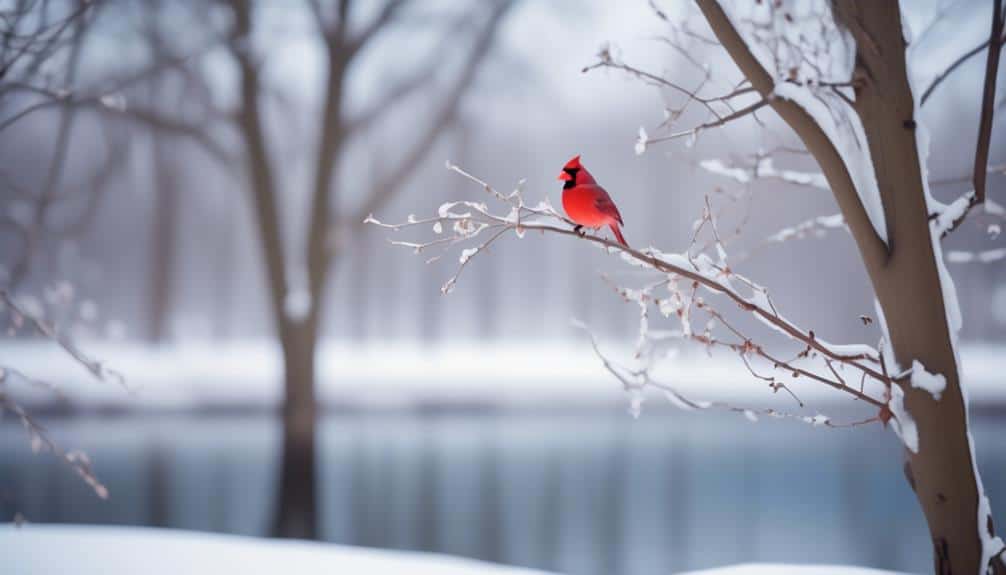
One can easily discover an array of winter birds in Wisconsin, making it a prime location for birdwatching enthusiasts during the colder months. With its diverse habitats and abundance of food sources, Wisconsin attracts a wide variety of migratory birds seeking refuge from harsher climates. The state's extensive network of wetlands, forests, and open fields provides ample opportunities for birdwatchers to spot these feathered visitors.
One of the best places to witness the winter bird migration in Wisconsin is Horicon Marsh. This National Wildlife Refuge is a haven for waterfowl, providing them with crucial resting and feeding grounds. Here, one can observe flocks of snow geese, tundra swans, and various species of ducks. The open water and surrounding wetlands attract not only waterfowl but also raptors such as bald eagles and northern harriers.
Another hotspot for winter birdwatching is the Apostle Islands National Lakeshore. This archipelago in Lake Superior is known for its diverse bird population. Visitors can spot common loons, mergansers, and goldeneyes diving for fish in the icy waters. The islands' forests are also home to owls, woodpeckers, and winter finches.
The Ice Age National Scenic Trail is another excellent option for birdwatchers. This trail traverses diverse landscapes, including prairies, woodlands, and kettle lakes. Look out for northern shrikes perched on shrubs, as well as red-breasted nuthatches and pine siskins feeding on conifer seeds.
Frequently Asked Questions
How Do Winter Birds in Wisconsin Migrate to Warmer Areas During the Winter Months?
Winter birds in Wisconsin migrate to warmer areas during the winter months based on their migration patterns and winter bird behavior. They instinctively follow specific routes and fly towards regions with more favorable climate conditions for survival.
What Is the Average Lifespan of Winter Birds in Wisconsin?
The average lifespan of winter birds in Wisconsin is influenced by various factors, including their migration patterns. Understanding these patterns is crucial for studying their survival strategies and the overall health of the population.
Are There Any Specific Types of Food That Winter Birds in Wisconsin Rely on to Survive?
Winter birds in Wisconsin rely on specific types of food sources to survive during the winter months. These food sources are crucial for their survival and are often obtained through their migration patterns.
How Do Winter Birds in Wisconsin Stay Warm During the Cold Winter Months?
To stay warm during the cold winter months, winter birds in Wisconsin have fascinating adaptations. They adjust their feeding habits, fluff up their feathers to create insulation, and seek shelter in tree cavities or dense vegetation.
Can Winter Birds in Wisconsin Survive in Urban Areas or Do They Primarily Inhabit Rural Areas?
Winter birds in Wisconsin have adapted to survive in urban areas. They can tolerate higher population densities and have adjusted their behaviors and diets to take advantage of the resources available in these environments.
Conclusion
In conclusion, Wisconsin is a haven for winter birds, offering a glimpse into the resilience and adaptability of these feathered creatures.
From the majestic Bald Eagle soaring through the sky to the lively Chickadee flitting among the trees, these birds have developed remarkable adaptations to survive the harsh winter conditions.
By exploring the best places to spot these magnificent creatures, one can truly appreciate the beauty and diversity of Wisconsin's winter bird population.
As the saying goes, 'The early bird catches the worm,' so venture out early to witness these extraordinary birds in action.

